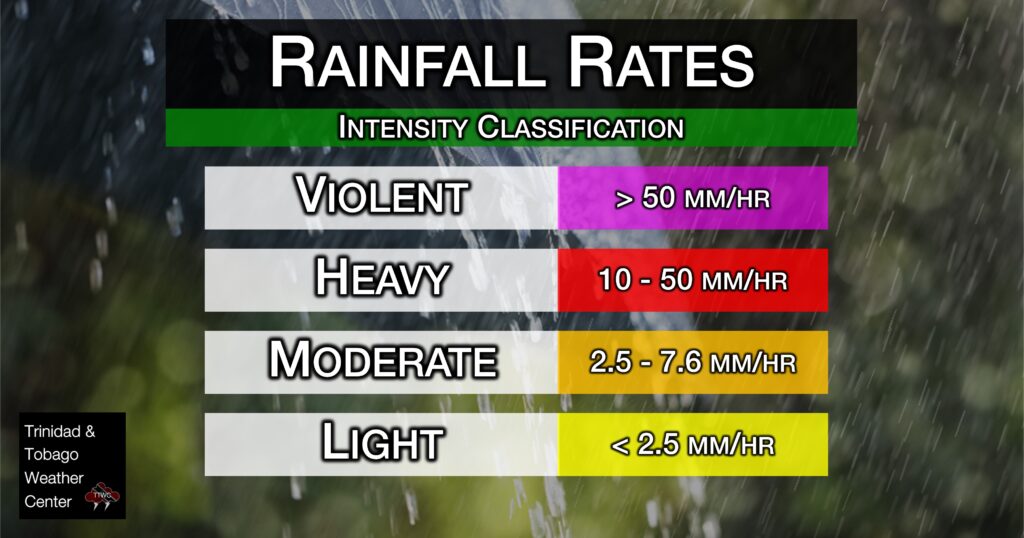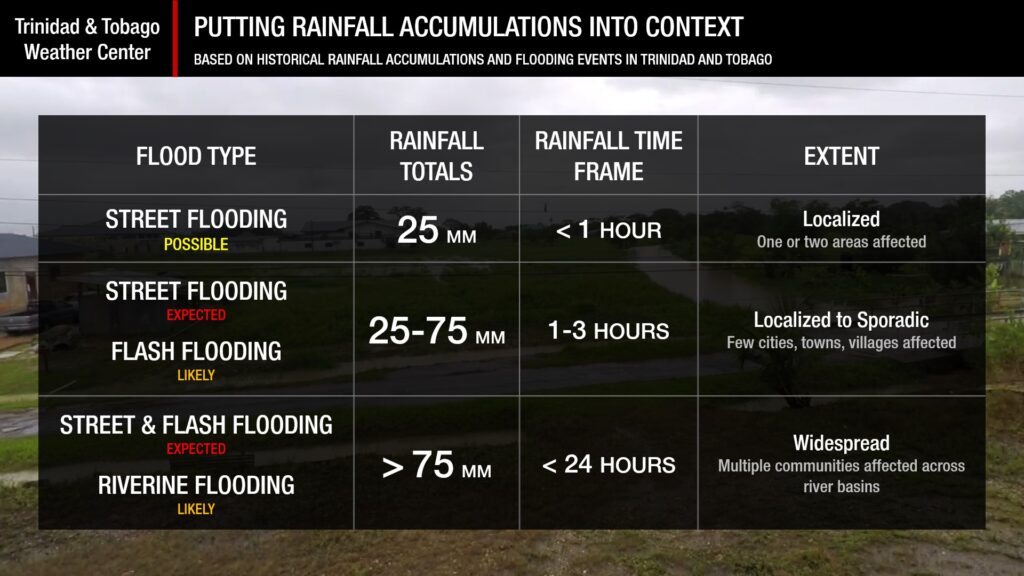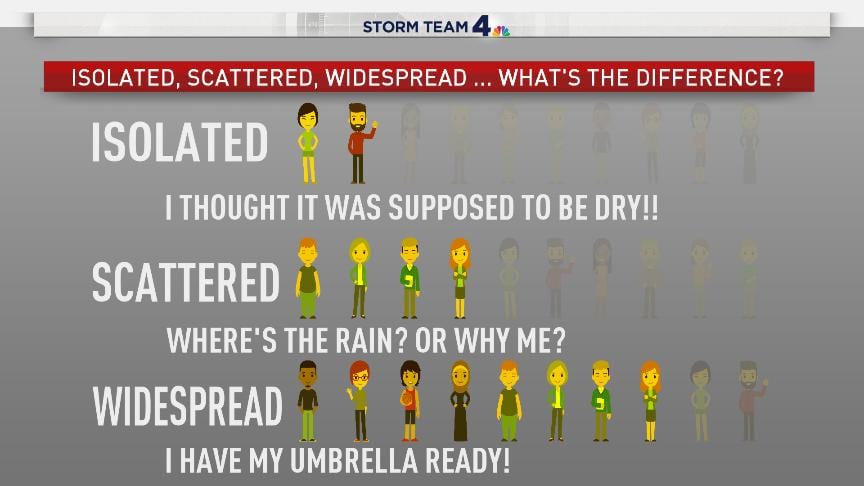Multiple weather features are forecast to affect T&T over the next five days, resulting in periodic showers and thunderstorms bringing welcome rainfall to the country. However, with the potential for heavy showers and isolated strong thunderstorms, localized street/flash flooding will be a concern near-daily.
What you need to know
— Rainfall: Over the next five days, between 30 and 80 millimeters are forecast across T&T, with higher totals trending across eastern Trinidad and Tobago. In isolated areas across eastern Trinidad and Tobago, up to 150 millimeters are forecast over the five-day period. In highly isolated heavy showers and thunderstorms, 24-hour rainfall totals could exceed 50 millimeters.
— Saharan Dust: Mild Saharan Dust is forecast across T&T over the next five days.
— Hazards: The main hazard over the next five days will originate from heavy showers and thunderstorms, producing cloud-to-ground lightning, gusty winds up to 50 KM/H, and periods of heavy/violent rainfall, which can trigger localized street/flash flooding.
— Marine: Seas are forecast to be moderate, with waves in open waters generally reaching as high as 1.5 meters, reaching as high as 2.0 meters from Sunday onward. In sheltered areas, waves are forecast to be up to 1.0 meter.
Latest Alerts
TTMS Maintains Adverse Weather Alert For T&T
Trinidad and Tobago is NOT under any tropical storm or hurricane threat, watch, or warning at this time.
The Forecast
Thursday
ThursdayFriday
FridaySaturday
SaturdaySunday
SundayMonday
MondayMarine Forecast
Slight to Moderate Seas Forecast For T&T
Temperatures
Thursday
Low: 25-26°C
High: 31-33°C
Friday
Low: 25-26°C
High: 29-31°C
Saturday
Low: 25-26°C
High: 30-32°C
Sunday
Low: 25-26°C
High: 30-32°C
Monday
Low: 25-26°C
High: 29-31°C
Maximum high temperatures are forecast to return to near to below-average levels for November across Trinidad and Tobago over the next five days due to forecast rainfall and cloudy skies, with actual temperatures reaching as high as 33°C across both islands. Across the country, over the next five days, the heat index, or feels like temperature, is forecast to range between 34°C and 44°C, as some days, particularly Sunday, partly cloudy skies will allow for warming. Heat indices above 42°C are dangerous. Minimum lows are forecast to range between 25°C and 26°C daily but can trend lower in interior areas of the country and across Tobago where rainfall persists.
Forecast Impacts
Flooding
FloodingForecast Rainfall Totals
- Thursday: Between 5 and 15 millimeters across the country, with totals between 15 and 35 millimeters across Tobago and isolated areas of southern and western Trinidad. Locally higher amounts in areas that receive persisting heavy showers or thunderstorms.
- Friday: Between 5 and 15 millimeters across the country and isolated totals up to 25 millimeters favoring eastern areas of Trinidad and western coastal areas. Locally higher amounts in areas that receive persisting heavy showers or thunderstorms.
- Saturday: Between 5 and 15 millimeters across the country and isolated totals up to 25 millimeters favoring the northern half of Trinidad. Locally higher amounts in areas that receive persisting heavy showers or thunderstorms.
- Sunday: Across Trinidad, most areas are forecast to receive less than 5 millimeters, with totals up to 15 millimeters across western coastal Trinidad, as well as the northeast quadrant of the island. Across Tobago, between 10 and 25 millimeters are possible, with locally higher amounts favoring eastern Tobago.
- Monday: Between 10 and 20 millimeters of rainfall across both islands, with isolated totals up to 35 millimeters, favoring interior central and southern Trinidad, as well as across Tobago. Locally higher amounts in areas that receive persisting heavy showers or thunderstorms.

Understanding Rainfall Accumulations
Putting the rainfall forecast into context, rainfall rates in excess of 50 millimeters per hour or areas that receive in excess of 25 millimeters within an hour tend to trigger street flooding across the country or flash flooding in northern Trinidad. For riverine flooding to occur, a large area of the country (not just in highly localized areas of western coastal Trinidad) would have to record upwards of 75 millimeters within 24 hours, and rainfall would have to fall across major rivers’ catchment areas.

Strong Thunderstorms
Strong ThunderstormsWhat is a strong or severe thunderstorm?
Given how rare these types of thunderstorms are in our region – we classify a severe or strong thunderstorm as one that produces any of the following:
- Damaging wind gusts exceeding 55 KM/H;
- Frequent lightning (more than 30 cloud-to-ground strikes within a 10-minute period);
- Hail (of any size);
- Rainfall of more than 50 millimeters or more within an hour or exceeding 75 millimeters or more within three hours;
- The sighting of a funnel cloud or touchdown of a waterspout/tornado associated with the thunderstorm.
Gusty Winds
Gusty WindsWith winds gusting to 55 KM/H, and occasionally above, whole trees can be in motion with larger trees and weaker branches falling. Light outdoor objects can topple or become airborne such as garbage cans, loose galvanize, construction material, and outdoor furniture. Tents may also jump. Note these impacts are mainly possible ahead of and during heavy/violent showers and thunderstorms.
Other Hazards
Saharan Dust Forecast
Dust-Free Days Ahead For T&T As Saharan Dust Stays North
Why I May Not/Will Not See Rainfall?
A frequent complaint is the forecast is wrong because I didn’t experience any rainfall. Scattered showers mean that you, individually, may experience some showers intermittently throughout the day, and there is a higher chance for this activity than isolated activity. Widespread showers mean that nearly all persons and areas may experience rainfall.
Over the next five days, isolated to scattered rainfall is forecast.

Forecast Discussion
On Thursday, an induced low-level trough is forecast to move across the Windward Islands, affecting Trinidad and Tobago as it interacts with the Intertropical Convergence Zone. Forecast models indicate the atmosphere to be generally favorable for rainfall, and relative humidity (moisture) remains high through the atmosphere with favorable upper-level divergence and elevated mixing at low levels of the atmosphere, all supportive of potentially strong thunderstorms. The sole limiting factor will be very strong wind shear (up to 50 knots) from the west, meaning heavier rainfall for T&T will remain east of the country.
A similar atmospheric profile exists on Friday into Saturday as mid to upper levels remain supportive of strong thunderstorms and heavy rainfall, with relative humidities even higher than Thursday (up to 90%) through the atmosphere and total precipitable water up to 2.25 inches (57 mm). Favorable low-level convergence will also be present across T&T. Note that for Friday through Saturday, forecast models indicate a slight to marginal risk of severe thunderstorms across T&T, with a moderate risk of severe thunderstorms north of T&T. This means there is the potential for hail or very heavy/violent rainfall in the vicinity of the Windwards, mainly between T&T and Grenada.
By Sunday, moisture levels will decrease, but another low-level trough will produce conditions at a low level favorable for showers and isolated thunderstorms. Shear will still remain strong from the west, preventing persisting heavy showers/thunderstorms.
On Monday, shear decreases to moderate levels (still from the west) while moisture levels (both relative humidity through the atmosphere and total precipitable water) increase, with showers and thunderstorms remaining in the forecast. However, a surge of Saharan Dust is forecast to move in at this time, leading to the low-level drying as the evening progresses.
Note that as an extended forecast goes further into the future, it is normal for the certainty to be reduced relative to the extended time period.












